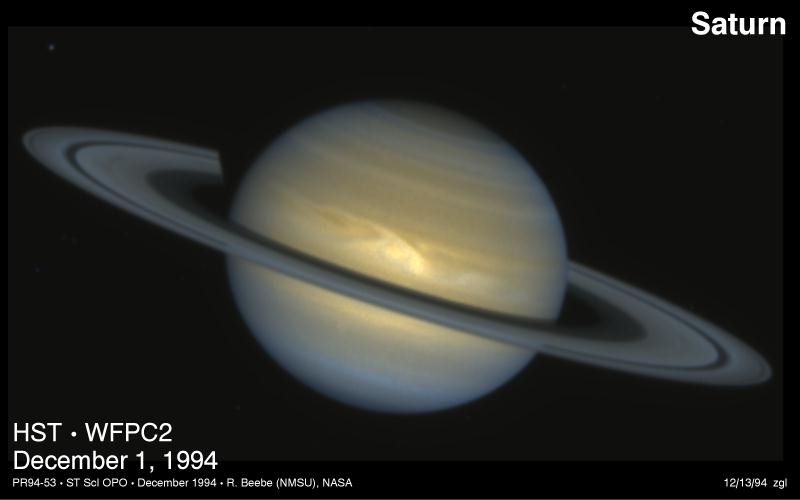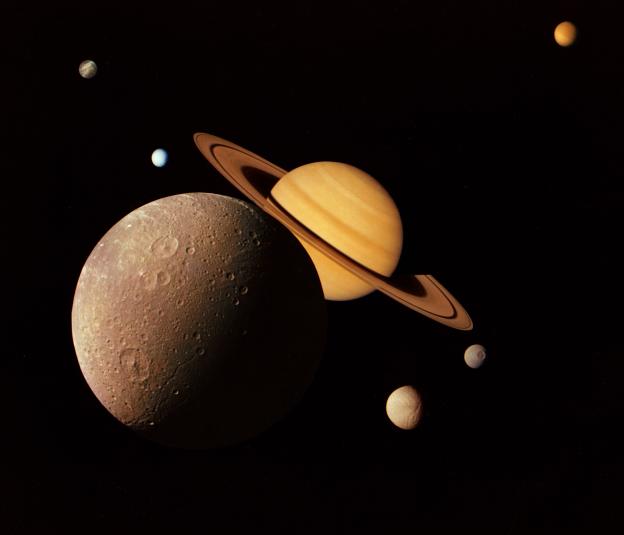
|
Документ взят из кэша поисковой машины. Адрес
оригинального документа
: http://zebu.uoregon.edu/disted/ph121/js20.html
Дата изменения: Sat Aug 5 23:51:15 2006 Дата индексирования: Tue Oct 2 04:14:19 2012 Кодировка: Поисковые слова: межзвездное пространство |

Saturn is 95 Earth masses and has a radius of 4.6 Earth radii. The atmosphere is primarily composed of hydrogen (94%) with small amounts of helium (6%) and methane. Saturn is the only planet less dense than water (0.7 gm/cc, i.e. it would float). Saturn's hazy yellow hue is marked by broad atmospheric banding similar to, but fainter than, that found on Jupiter.
One of the more obvious features is Saturn's ring system. Inclined at 27 degrees, the rings can be seen at various angles during Saturn's year. The last plane crossing was in May of 1995.
Saturn's Atmosphere:
Saturn's features are hazy because its atmosphere is thicker. On Jupiter, its mass is greater, therefore its gravity is higher and the atmosphere is compressed to 75 km in thickness. On Saturn, the low mass means lighter gravity and the atmosphere is thicker at 300 km from top to bottom.

The result is that Saturn's atmosphere has more haze and its features (turbulence, cyclones, etc.) are blurred and hard to see plus the colors are muted into a general yellowish hue.
The wind blows at high speeds on Saturn due to more energy emitted from its core as compared to Jupiter (see below). Near the equator, it reaches velocities of 1,100 miles an hour. The wind blows mostly in an easterly direction. The strongest winds are found near the equator and velocity falls off uniformly at higher latitudes. At latitudes greater than 35 degrees, winds alternate east and west as latitude increases.
This movie, taken by the Hubble Space Telescope, shows a rare storm that appears as a white arrowhead-shaped feature near the planet's equator. The storm is generated by an upwelling of warmer air, similar to a terrestrial thunderhead. The east-west extent of this storm is equal to the diameter of the Earth (about 12,700 kilometers). The Hubble images are sharp enough to reveal that Saturn's prevailing winds shape a dark "wedge" that eats into the western (left) side of the bright central cloud.
Saturn's Radiation Output:
As with Jupiter, Saturn radiates more energy than it absorbs from the Sun. In fact, it emits 2.3 times more energy than it receives. Jupiter's remnant heat is leftover energy from the time of formation. But, since Saturn is less massive than Jupiter, it should have less leftover energy yet it radiates more than Jupiter.
The answer to this dilemma lies in the missing helium in Saturn's atmosphere. Most of the Jovian worlds have what is called primordial abundances; 90% hydrogen, 9% helium and traces of everything else. This is the same abundance of elements that makes up the whole Universe. Notice that the inner worlds are very different in abundances due to the changes from being too close to the Sun and too warm (they evolved into their current states). But the Jovian worlds have the same composition now as when they formed. But Saturn is deficient in helium. Its composition is 94% hydrogen and 6% helium, some helium is missing from the atmosphere.
The process was as follows:
The result is a warmer core and a lack of helium in the upper atmosphere of Saturn.
Saturn's Interior:
Saturn is more oblate than Jupiter. From this we deduce that its concentration of mass at the center is less than that of Jupiter. Note this is not the same statement that its rocky core is smaller. In fact, the cores of Jupiter and Saturn are similar. Saturn has a much smaller shell of metallic hydrogen, i.e. thinner metallic hydrogen mantle, thicker molecular hydrogen ``crust''.

Saturn's Magnetic Field:
Saturn's magnetic field is 8,000 times the strength of the Earth's magnetic field. This is quite strong, but less than 1/2 of Jupiter's magnetic field strength due to the fact that Saturn's metallic hydrogen shell is smaller than Jupiter's.
Saturn's magnetosphere is smaller and there is no current sheet like Jupiter's. This is due to two reasons; 1) the magnetic field is less strong, therefore the magnetosphere is smaller, and 2) the rings of Saturn serve to damp out the charged particles that we saw associated with Jupiter's system.
This image shows the first image ever taken of bright aurorae at Saturn's northern and southern poles, as seen in far ultraviolet light by the Hubble Space Telescope. The aurora is produced as trapped charged particles precipitating from the magnetosphere collide with atmospheric gases. Hubble resolves a luminous, circular band centered on the north pole, where an enormous auroral curtain rises as far as 2,000 kilometers above the cloudtops. This curtain changed rapidly in brightness and extent over the two hour period of HST observations.
Saturn is also surrounded by an extensive system of moons.

Characteristics of some of the satellites: